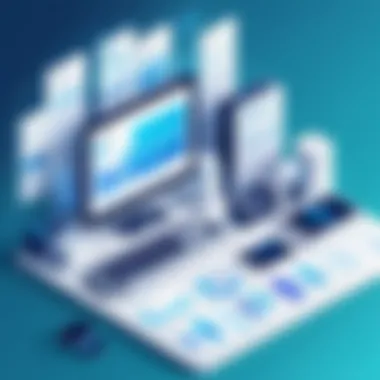Exploring Residential Utility Billing Systems


Intro
Residential utility billing systems are foundational to how households interact with their resource providers, primarily in water, gas, and electricity sectors. These systems bridge the communication gap between service providers and customers, instrumental in effective resource management and satisfaction. A smooth billing process is not just about payment; it encompasses accurate usage tracking, timely invoicing, and responsiveness to customer inquiries.
Understanding these systems involves examining various aspects, from their design to the regulatory framework that envelops them. Today’s utility providers face increasing pressure to innovate while managing costs and enhancing user experience. As we delve into this exploration, it is essential to reflect on how these systems continuously evolve to meet modern demands while considering the implications for both customers and utility providers.
Industry Overview
Efficiency and accuracy are more critical than ever in the utility market. Increasing operational costs, regulatory demands, and customer needs are pushing utility billing systems to transform.
Current Trends in the Industry-specific Software Market
Organizations are adopting software that integrates features such as real-time data analytics and user-friendly interfaces. This is resulting in
- Better customer insights
- Improved billing accuracy
- Enhanced self-service capabilities
Key Challenges Faced by Buyers in the Industry
The software buyer encounters significant challenges, including:
- Navigating complex compliance regulations
- Evaluating scalability potential for growing needs
- Ensuring data security against cyber threats
Emerging Technologies Impacting the Industry
Various advanced technologies, including artificial intelligence and machine learning, are starting to influence residential utility billing systems. These technologies can predict consumer behaviors and improve operational efficiency, thus optimizing resource allocation.
Top Software Options
Selecting the right billing software is a decisive step for utilities wanting to enhance their operations. Choosing among competing solutions demands careful consideration.
Review of Leading Software Providers in the Industry
Some of the notable software options available include:
- Oracle Utilities: Known for detailed customer engagement tools.
- SAP Convergent Charging: Focuses on pricing flexibility and integration.
- Harris Utilities: Provides solutions tailored to smaller utilities.
Feature Comparison of Top Software Solutions
Different products offer unique features. When examining them, consider:
- Data Management: How deeply the software can analyze and forecast utility data.
- Customer Interaction Tools: Features that enable interaction between the service provider and consumers.
- Third-party Integration: Compatibility with existing systems.
Pricing Structures of Different Software Options
Pricing can vary wildly based on company scale and system features. Most vendors offer tiered pricing models catering to both small and large utilities, ensuring diverse needs can be met.
Selection Criteria
Choosing the right software involves several critical considerations. Look closely at:
- Deployment Options: Hosted vs. on-premise solutions
- User Support and Training: Quality of training resources
- Scalability: Adaptation to future organizational growth
Common Mistakes to Avoid During the Selection Process
Avoid these common pitfalls:
- Shedding features that seem unnecessary initially
- Ignoring customer support options
How to Determine the Right Fit for Your Business Needs
Identify your key requirements early. It may be wise to involve stakeholder input across technical and operational divisions of your organization.
Implementation Strategies
An effective strategy ensures smoother transitions when an organization adopts new software.
Best Practices for Smooth Implementation of Software Solutions


Utilize phased implementation strategies. Piloting the software in selected areas can help refine approaches based on feedback.
Integration with Existing Systems and Processes
Effective integration with existing infrastructure is necessary to avoid disruptions. Open APIs can provide the necessary hooks into other software systems.
Training and Support Resources for Successful Deployment
Invest in comprehensive training. A lack of user understanding often leads to software underutilization or operational errors.
Future Trends
The utility billing field will continue to evolve with technology. Predictions indicate greater personaliztion through demand-response programs, aligning billing models to customer consumption patterns.
Upcoming Technologies Shaping the Industry
Sometimes, advancements such as blockchain struggle for mainstream acceptance but hold promise for secure decentralized transactions between customers and utility companies.
Recommendations for Future-Proofing Your Technology Stack
It is wise to select adaptable software Solutions maintaining focus on continuous support and upgrade options.
"Utilities able to seamlessly adopt new technologies can set themselves apart in an increasingly competitive marketplace."
Intro to Residential Utility Billing Systems
Residential utility billing systems play a crucial role in the management of essential services like electricity, water, and gas. Understanding these systems can drive significant improvements in operational efficiency for utility providers while also enhancing customer satisfaction, a key concern for both businesses and households alike. These systems are not merely a tool for transaction processing; they encapsulate the intricate relationship between utility providers' supply chains and consumer usage patterns. A robust utility billing system has the potential to streamline billing processes, thus reducing dispute occurrences, simplifying payment methods, and increasing transparency.
Definition and Purpose
A residential utility billing system refers to the software and procedures that track and calculate utility usage for individual households. By incorporating advanced data analytics, these systems enable utility firms to generate accurate bills based on real consumption data. Additionally, they facilitate customer notifications, payment tracking, and account management tasks. A well-structured billing system helps households better understand their utility consumption and manage their financial planning effectively. With increased visibility, homeowners can adopt strategies for energy conservation, thereby reducing both their bills and environmental impact.
Moreover, these systems perform the critical function of integrating various operational processes for utility providers. They help in reporting regulatory compliance and budgeting considerations, making it central in the pipeline management aspect of service utilities. As an important touchpoint, the billing system has the capability to influence customer trust and loyalty.
Importance in Modern Utility Management
The modern landscape of utility management is evolving with technological advancements and growing sustainability demands. The incorporation of an efficient billing system is fundamental. These systems provide metrics essential for optimized energy management. By analyzing consumption data, utility providers can forecast demand, identify waste, and implement resource management strategies more intelligently.
Implementing modern utility billing systems also strengthens customer management by offering self-service options. Customers increasingly prefer online interaction, from monitoring usage in real time to viewing bills. Thus, an effective billing platform mitigates potential dissatisfaction among consumers and reaffirms utility providers commitment to customer service.
Effective billing processes create a crucial bond between providers and users, thereby helping to build a sustainable future for all.
Key Components of Billing Systems
The development of a residential utility billing system lays its foundation on several key components. These components form the backbone of effective utility services and ensure efficient management of resources. Recognizing the intricate workings of these elements is essential for decision-makers focused on improving systems for residential billing. This section will delineate the significant components that contribute to the overall functionality of billing systems, emphasizing their consequences and advantages.
Meter Acquisition and Data Collection
The process of meter acquisition and data collection is crucial in any utility billing system. It starts with the installation of physical meters that measure utilities such as water, electricity, and gas with precision. With advancing technology, many utility providers are now adopting smart meters. These devices provide real-time data, allowing for more accurate usage calculations.
The use of automated data collection systems is favored over traditional manual entries. Benefits include:
- Increased accuracy: Reduces human errors in data recording.
- Timely updates: Continuous data collection allows for up-to-date information, promoting faster billing cycles.
- Enhanced analysis: Gathered data can be analyzed for patterns that can inform future resource allocations and efficiencies.
Moreover, continuous data flow from smart meters enables utility companies to create targeted programs aimed at reducing consumption patterns by providing useful insights back to households.
Billing Calculation Mechanisms
Next is the billing calculation mechanism. This stage processes collected data into structured billing formats. Different methodologies dictate how bills are calculated according to utility type and the regulatory environment. Often included factors are:
- Base rates: Standard costs that all customers must pay.
- Variable rates: Rates that fluctuate based on usage patterns, encouraging energy conservation and optimal use across peak hours.
Incorporating flexible pricing models, such as time-of-use pricing, can offer tangible benefits for both the utility and customers. Such strategies can lead to a reduction in peak demand charges, subsequently lowering operational costs for utility providers.
Engaging in detailed audits of billing mechanisms will cristally improve clarity for consumers while tapping into revenue opportunities for utilities.
Customer Account Management
FA potential linchpin in any fulfilling billing system is effective customer account management. This includes maintaining data accuracy for users, ensuring clear communication and customer support throughout their utility return service experience.


A comprehensive customer management system can include features like:
- User portals: Allowing customers to view and manage their own accounts.
- Early warning systems: Sending alerts for anomalous consumption or overdue payments, helping prevent service disruptions.
- Feedback loops: Mechanisms for receiving user input into service improvements.
Valuable previously collected customer data helps in developing tailored solutions that enhance satisfaction and retention from end-users perspective. Overall, solid account management enhances client relationships and can lead to substantive long-term business growth.
Understanding and honing these key components can transform refined artisan utility management into consistent performance across sectors, which is critical in an expanding and increasingly interconnected environment.
Technological Foundations
Technological foundations are crucial in the landscape of residential utility billing systems. As utilities strive to deliver precision and efficiency, the software architecture, integration with Internet of Things (IoT) devices and smart meters, along with robust data analytics reporting tools, play significant roles. The implementation of advanced technology not only enhances operational capabilities but also improves customer satisfaction. Moreover, understanding this foundational technology equips decision-makers and professionals with the knowledge needed for effective resource management.
Software Architecture
Software architecture serves as the backbone of residential utility billing systems. It determines how well the system will function under various demands. A solid architecture is essential, ensuring interoperability between breathing segments like collections, calculations, and user interactions.
The design must accommodate scalability to handle fluctuations in user numbers and transaction volumes. Coupled with high-level security measures, this reduces the risk of data breaches dramatically. A well-structured architecture enables seamless updates and integration of improvements like enhanced billing formats or added features. Such capabilities not only help in meeting customer demands but validate the utility's commitment to service satisfaction.
Integration with IoT and Smart Meters
The next fundamental aspect involves integration with IoT technologies and smart meters. Smart meters represent a shift from traditional mechanical meters. These devices provide, in real-time, insights on resource consumption behaviors, helping both utility providers and residential users make informed decisions.
Incorporating IoT allows these smart meters to communicate their data instantaneously through connected networks. Utilities can adjust billing according to time-of-use data, possibly enabling dynamic pricing strategies. This reliance on technology supports predictive modeling for usage trends and declines in overdraft.
These integrations permit remote reading of meters and minimize manual interventions. This change leads to fast data collation leading to more accurate billing. Besides, customers experience immediate feedback and can modify their consumption habits based on analyzed data which educates and engages them effectively.
Data Analytics and Reporting Tools
Finally, data analytics and reporting tools shape the decision-making processes for utilities. Leveraging such tools allows organizations to analyze consumption patterns, user demographics, and other critical metrics. This intel informs operational strategies, pricing policies, and marketing efforts.
- Enhanced Reporting: Rich reporting capabilities support transparent interactions with consumers, as utilities can provide detailed statements reflecting consumption metrics clearly.
- Utility Trends: Analytics helps in forecasting not only the demand spikes but also maintenance needs of the infrastructure, therefore safeguarding service consistency.
- Customer Engagement: Insights derived from analytics models pave the path for deeper customer engagement—strategically targeting offerings based on bill frequency, consumption habits, and responsiveness.
Ultimately, a comprehensive grasp of how these technological foundations synergize empowers stakeholders to implement more refined utilities management strategies, eliminating redundancies and understanding customer expectations better.
The construction of a robust technological foundation is not merely a matter of choice; it has become a necessity in contemporary utility management.
Regulatory and Compliance Considerations
Regulatory and compliance considerations play a crucial role in the management of residential utility billing systems. These frameworks ensure that companies adhere to necessary legal and ethical standards while offering services to the public. Noncompliance can lead to severe ramifications, including loss of customer trust and legal penalties.
Federal and State Regulations
Federal regulations govern a range of utility activities in residential billing. For example, the Public Utility Regulatory Policies Act (PURPA) mandates certain standards planners are expected to meet. Such adherence protects consumers from unfair practices and boring rates. State regulations vary, with each domicile presenting its unique guidelines on rates. Key aspects include utility service quality, transparent billing, and rate change notifications.
- Utility Rate Structures: Different tariffs for residential, commercial, and industrial users.
- Service Quality Standards: Minimum standards must be maintained by utility companies regarding outages and response times.
- Customer Notification for Rate Changes: Customers should receive advance notice about changes.
Compliance frameworks not only protect consumers but also support utility providers in ethical operations. Strong compliance contributes to enhanced reputational concernts among utility providers.
Data Privacy and Security Concerns
Data privacy and security are paramount in an era dominate by technology priorities. As residential utility billing systems evolve, managing customer data responsibly becomes central to corporate ethics and regulatory compliance. Data breaches can lead to significant consequences, both legally and ath the customer level.
Utility providers must deploy protective measures, including:
- Encryption Protocols: Ensure sensitive data in transit and storage is encrypted to prevent unauthorized access.
- Access Controls: Limit access to data based on employee roles to minimize the risk of internal breaches.
- Stay Updated on Policies: Regularly reviewing privacy policies to align with changing laws, such as the GDPR, safeguards the organisation.
"Security is not just about protection but also maintaining trust with customers."
A robust approach toward data privacy fuels customer confidence. Implemented correctly, addressing these regulations ensures dignity versus domestic life expenses and provides clarity throughout the charge processes.
Accordingly, organizations factor each element above into their strategic planning processes to mitigate risks and facilitate efficient and transparent billing systems.
Challenges and Limitations
Understanding the challenges and limitations in residential utility billing systems is crucial for both utility providers and consumers. These aspects can significantly affect operational efficiency and customer satisfaction. This section will showcase specific challenges faced by utility providers and examine the barriers impacting customer interaction.
Operational Challenges for Utility Providers
Utility providers encounter numerous operational challenges when managing billing systems. These include:


- Data integrity issues: The accuracy of billing relies on correct data from meters. A problem with meter reading can lead to incorrect charges, causing disputes.
- System integration: Residential utility billing systems often struggle to integrate with legacy infrastructure and new technology. This mismatch can restrict functionality and lead to inefficiencies.
- Resource constraints: Many utility companies suffer from limited personnel and financial resources. Managing system upgrades and training staff can become difficult.
- Regulatory compliance: Each region may impose different billing regulations, complicating operations. Providers must navigate complex legal landscapes, affecting the flexibility of their systems.
Addressing these operational obstacles ensures that utility providers maintain accurate, efficient, and legally compliant billing processes. Failure to manage these challenges effectively could hamper the overall quality of service.
Customer Interaction and Satisfaction Issues
Customer satisfaction plays a vital role in utility billing systems. A smooth user experience increases adherence and trust among users. Here are several issues that can arise:
- Confusing billing statements: Complicated bills can alienate users. If customers struggle to comprehend charges, it undermines their trust.
- Delayed notifications: If there's a problem with an account, quick communication is critical. Delayed responses can create frustration for consumers.
- Limited payment options: Contemporary consumers expect convenience. Limited payment methods can lead customers to seek alternatives.
- Inadequate customer service: Long wait times and insufficient management of inquiries create barriers to effective resolution.
Improving customer interaction directly impacts satisfaction and retention. Ultimately, these issues demand balanced strategies from utility companies to engage and support their user base effectively.
Addressing these challenges ensures efficiency in operaion and enhances overall customer experience.
Future Trends in Residential Utility Billing
In the ever-evolving landscape of residential utility billing, identifying future trends is essential for understanding how energy and water sectors may adapt to ongoing technological and societal changes. This section will address the emerging paradigms of artificial intelligence and machine learning, along with the greater emphasis on sustainable practices within billing systems. Both elements play crucial roles in shaping the effectiveness, efficiency, and environmental implications of utility billing.
Adoption of AI and Machine Learning
The rise of artificial intelligence (AI) and its integration into utility billing systems is becoming more pivotal. AI encompasses various technologies such as machine learning, cognitive computing, and predictive analytics. By adopting these technologies, utility companies can enhance their operational efficiencies and deliver better service to customers. The benefits include:
- Enhanced Data Processing: AI can analyze vast amounts of data from various sources far quicker than traditional methods. This capability leads to improved accuracy in billing calculations and consumption assessments.
- Customer Engagement: Customized messaging and engagement can be framed using AI analytics. Companies utilize these insights to anticipate customer needs, thereby improving satisfaction.
- Predictive Analysis: Machine learning can predict consumption patterns, enabling utilities to optimize resource distribution. For example, forecasting peak consumptions can assist in load management and energy conservation initiatives.
AI's role extends beyond billing accuracy; it also contributes to robust fraud detection mechanisms by flagging anomalous usage patterns. As more companies transition towards smart technologies, embracing AI will not just be beneficial; it will become a necessity.
Sustainable Practices in Billing
With a growing focus on environmental sustainability, billing methods are adapting to reflect green principles. This trend is gaining momentum as society becomes more conscious of environmental impacts. Strategies include:
- Paperless Billing: More utility providers are encouraging digital statements to reduce paper consumption. Online billing saves costs and simplifies the interaction process for customers who prefer quick access to statements.
- Energy Conservation Initiatives: Some utility companies embed consumption tracking tools within billing frameworks, empowering consumers to monitor their usage. By visualizing their energy consumption, customers can adopt more sustainable habits.
- Incorporating Renewable Energy Credits: Billing systems are increasingly integrating features that allow customers to support renewable energy initiatives. For instance, customers might be offered the option to purchase renewable energy credits, effectively allowing them to contribute toward sustainable energy sources.
These sustainable practices align with broader environmental goals and resonate with customers dedicated to reducing their carbon footprint. More utility providers will pursue innovative strategies to stay competitive and engaged with environmentally-conscious clientele.
Future trends like AI integration and sustainability programs are set to redefine how residential utility billing operates, creating value for providers and consumers alike.
In summary, as utility providers look towards the future, adopting advanced technologies like AI and instigating sustainable billing practices will play significant roles in enhancing operational effectiveness and meeting customer demands. Staying informed on these trends is important for decision-makers to navigate the challenges and opportunities inherent in evolving utility landscapes.
Best Practices for Implementation
Implementing residential utility billing systems effectively requires an understanding of best practices. This section discusses these practices and explains their significance step by step. Proper implementation results not only in efficient operations but can also greatly enhance customer confidence and satisfaction.
Stakeholder Engagement
In any utility billing project, engaging stakeholders cannot be understated. Stakeholders are varied and can include utility management, IT teams, financial officers, and, importantly, the customers themselves.
- Feedback Loops: Regularly inviting opinions from the various stakeholders creates a system attuned to the needs of its users. This feedback can inform necessary adjustments in billing protocols and help identify potential issues before they evolve into larger problems.
- Workshops and Meetings: Organizing workshops ensures all stakeholders understand the changes in processes and systems. Keep initial meetings extensive, where discussions will nurture collective input on billing features and disclosing their impacts on customers.
- Transparent Communication: Clear communication about forthcoming changes allows stakeholders to develop more confident expectations of new implementations.
Active engagement not only avoids later pitfalls but also cultivates an environment of cooperation and readiness for future innovations.
Continuous Improvement Strategies
The last component in the best practices life cycle is adopting continuous improvement strategies. Rapid technological advancements and changing customer expectations mean that billing practices must remain flexible and responsive.
- Regular Training: Providing ongoing training helps staff stay aware of developments within the utility billing landscape. Teams knowledgeable in upgrades can ensure the system is used to its fullest potential.
- Performance Metrics: Establish clear metrics to evaluate performance regularly. These metrics can cover various aspects, such as processing speed and customer dispute resolution.
- Integration of Feedback Mechanisms: Deploy mapping techniques to engage with customer concerns. Identify any recurring issues by analyzing bill audits and surveys, and this can drive modifications as necessary.
- Adapt to Trends: Observing shifts within consumer behavior can pin several directions to forecast needs and initiate changes to your service. Using adaptable processes creates a genuine chance to stay relevant.
For optimal utility management, remember: Implementing best practices should not be sporadic but become systematic to maintain high standards across all billing functions.
Ultimately, adopting these best practices leads to more reliable and efficient billing systems, ensuring triumph in tackling future challenges, and uplifting customer expectations in direct comprehensive routines.
Ending and Key Takeaways
The conclusion of this article efficiently summarizes the importance of effective residential utility billing systems. In our increasingly complex world of energy consumption and resource management, utility billing serves as a critical bridge between service providers and consumers. Well-designed billing systems not only streamline the billing process but also enhance transparency and ensure accuracy. This relationship between accuracy and transparency ultimately fosters consumer trust.
Summarizing the Importance of Effective Billing
Effective billing can have significant impacts on both utility providers and their residential consumers. For providers, a streamlined billing process decreases operational costs and reduces the number of disputes regarding charges. This can lead to more efficient use of resources, allowing providers to focus on improving service delivery.
For customers, understanding their bills is crucial in managing energy consumption. Utility bills that clearly display charges, usage data and any surcharges offer consumers knowledge about their patterns of usage. This might encourage better energy habits and lead to cost savings. In a survey by the Energy Information Administration, a high percentage of consumers reported confusion about complex billing practices. Addressing this issue can potentially increase customer satisfaction and loyalty.
Implications for Future Developments
As technology continues to evolve, future developments in residential utility billing are essential to discuss. The incorporation of smart meters and real-time data analysis leads to more accurate billing practices. Customers may receive alerts about their energy usage which further promotes responsible consumption.
Furthermore, the rise of advanced analytics and artificial intelligence can aid utilities in understanding consumer behavior and optimizing usage forecasts. Decision-makers need to consider these advancements when strategizing for the utility industry's sustainability in a rapidly changing energy landscape. Properly applying these technological innovations can have long-term benefits, improving operational efficiencies and fostering customer relationships.
As legislative environments evolve, clear communication regarding compliance requirements will be agar in future billing practices as well. This understanding will further refine the regulatory landscape which interacts so heavily with these systems.
In closing, effective residential utility billing systems play a fundamental role in the operational success of utility providers and the satisfaction of customers. As future innovations are adopted, the emphasis should remain on enhancing user experience while ensuring clarity, compliance, and efficiency.



